The state of Missouri has a wealth of natural diversity, with varying landscapes, plants, and animals. And, of course, mushrooms! There are hundreds, if not thousands, of species in Missouri throughout the different ecosystems.
All this makes for great mushroom hunting! There are many edible species that grow in Missouri, including some culinary favorites like morel and oyster mushrooms.
In this guide, I’ll explain Missouri laws about mushroom hunting, what species can be found, and when to go looking. If you want to learn more about mushroom hunting, this is your place to start!
Getting Started
Many people won’t even try mushroom hunting because they’re scared of picking a toxic mushroom. This is a serious concern and you definitely shouldn’t downplay the risk. However, through learning how to easily identify the edible and highly toxic mushrooms, you can gain confidence about your finds.
When it comes to eating wild mushrooms, you need to be 100% sure of your find if you’re going to eat them. But you have to start somewhere! Learning to identify mushrooms takes time, so you need to accept that you won’t be able to positively identify mushrooms right away.
Tons of people don’t realize that mushroom hunting is a lot more about studying mushrooms, and eating them is just a bonus! For expert foragers too – sometimes they don’t have any luck and have nothing to bring home.

Mushroom hunting is a lot more about studying mushrooms than eating mushrooms.
©iStock.com/Oksana Styranets
Resources for Missouri
In this post, I’ll cover several common questions about mushroom hunting in Missouri. But, of course, I won’t be able to cover everything there is to know. There’s so much to learn about mushrooms, which means there are so many resources you can tap into!
It’s important to reference multiple sources so you can get a complete idea of the species in your area, the local rules, and the best hunting spots. Whether you’re a beginner or an experienced forager, there’s always more to learn.
Free resources like the Missouri Department of Conservation’s field guide or their ebook on mushroom species make it easy to start studying local species.
It’s also a great idea to join the Missouri Mycological Society (MOMS). Joining a mushroom group is a great way to get first-hand experience in a safe setting and learn from the experience of others. Mushroom hunting is mostly about building up knowledge, so it’s hugely helpful to work with people with years under their belt.
MOMS has several chapters so you can meet people in your area and find local spots. These include:
- Saint Louis
- Kansas City
- Springfield
- Mid-Missouri
- Southeast Missouri
They even have a cooking club that meets throughout the year! MOMS hosts mushroom-identifying classes and sends out a newsletter to its members. These are great resources to tap into!
Laws and Regulation for Mushroom Hunting
Most parks have regulations in place to moderate mushroom hunting so that the practice doesn’t destroy the ecosystem. Note that all these rules are for personal consumption only, you need a special permit to collect mushrooms for commercial use.
Mushroom hunting is allowed in state parks in Missouri with a cap of two gallons per day per person. However, it’s always best to call ahead and confirm since there can be changes or variations between parks. For example, Babler State Park says they allow two pounds per person.
National forests also allow mushroom hunting without a permit, with a cap of one gallon per day per person. Typically, national parks prohibit mushroom hunting but you can call your local park to ask for their specific stance.
Collecting mushrooms on private property is only allowed with explicit permission from the owner. Of course, this means that you can collect mushrooms on your own property if you find some!
General Foraging Tips
Just as important as foraging legally is foraging responsibly and respectfully. Here are some tips for collecting mushrooms so that you leave a small but positive impact!
First off, and most importantly, only take as much as you’ll use. Even if you find an area with tons of edible mushrooms, don’t take them all for yourself. There are forest animals and other foragers that would like to enjoy those mushrooms!
It helps to “tap the cap” or carry the mushrooms in a wicker basket or mesh bag to spread the spores. The spores are essential in the production of new mushrooms. When you pick a mushroom, it’s possible that you’ve picked it before it released its spores, but tapping it or carrying the mushrooms in a loose-material bag helps the spores get distributed.
Once you spot the mushroom you’re hunting, be on the lookout for more! Mushrooms often grow in groups in the same area or around the same tree, so if there’s one there are probably more.
At the same time, stay cautious! It’s easy to get tunnel vision once you spot a mushroom, but don’t be negligent. There could be snakes around or a drop in the terrain, so don’t forget to be aware of your surroundings.
Lastly, it’s essential that you leave no trace. Clean up after yourself and be respectful to the plants and wildlife surrounding you. Destructive practices harm the environment and leave a bad impression for all mushroom hunters.
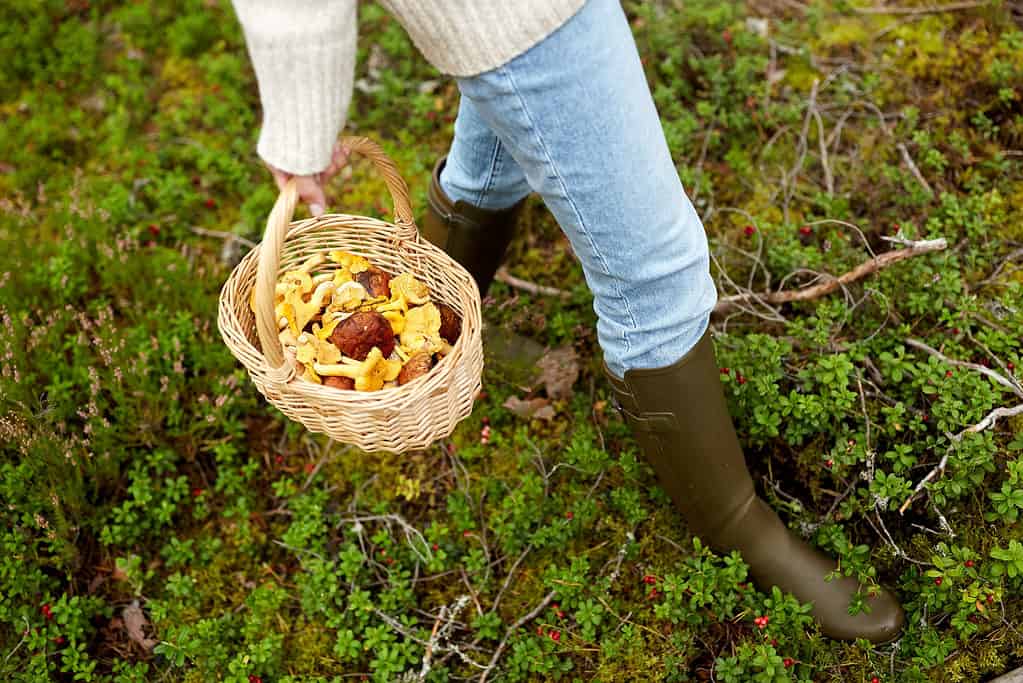
Carrying the mushrooms you’ve picked in a loose-material bag or wicker basket helps the spores get distributed.
©iStock.com/dolgachov
Common Edible Mushrooms
There are a handful of species that are well-known, sometimes all over the world, for being safe to eat and super tasty. We call these “choice edibles.” However, even for the safest mushrooms, always cook wild mushrooms.
Mushrooms absorb and decompose the toxins in their environment. So, you should never eat a mushroom raw because cooking the mushroom helps break down any toxins it might have soaked up.
This is also why you should only collect mushrooms from clean spaces. It’s possible that mushrooms growing along busy roads or fertilized lawns, for example, have soaked up chemicals from these places.
If you’re mushroom hunting with hopes of bringing home food, here are three species to look out for!
Morel (Morchella spp.)
These mushrooms are some of the most sought-after in the world because of their rich and nutty texture. Also, morels are “true wild mushrooms” meaning that they can’t be cultivated, so they only come from the forest.
There are several species of morels that can be found in Missouri and they’re all edible! Morels have a unique cap that makes them easy to identify for beginner hunters.
Except, these mushrooms are very small so you have to look hard! They’re typically only 3 to 4 inches tall. Their color depends on the species but ranges from cream-white to tan to blackish brown- so they blend in easily on the forest ground.
Morels are springtime mushrooms and they usually pop up around mid-April in Missouri. They also need lots of moisture, so fresh spring showers often prompt their growth. They will continue into the summer until the weather becomes too hot and dry.
Once temperatures stay at 70 Fahrenheit for a few straight days, you’re likely to find morels. Some experienced Missouri hunters have found that morels appear around the same time the lilac blooms!
They’re often found near elm, ash, and cottonwood trees, but they don’t have a specific tree they always grow by. Morels are also known to grow in disturbed places like old orchards or previously flooded areas. Join the Missouri Morel Hunting Facebook group to get updates as morel season approaches!
Oyster (Pleurotus ostreatus and Pleurotus pulmonarius)
Oyster mushrooms are well known because they have a very neutral taste, so they can be cooked in many ways! They’re also super easy to grow and have become a popular commercial species.
These mushrooms like to grow on wood, typically dead or decaying logs or stumps. Oyster mushrooms love fallen branches on the forest floor!
The first species, Pleurotus ostreatus, can grow all year round if there’s enough moisture. Pleurotus pulmonarius does better in warmer weather and often grows in the spring and summer.
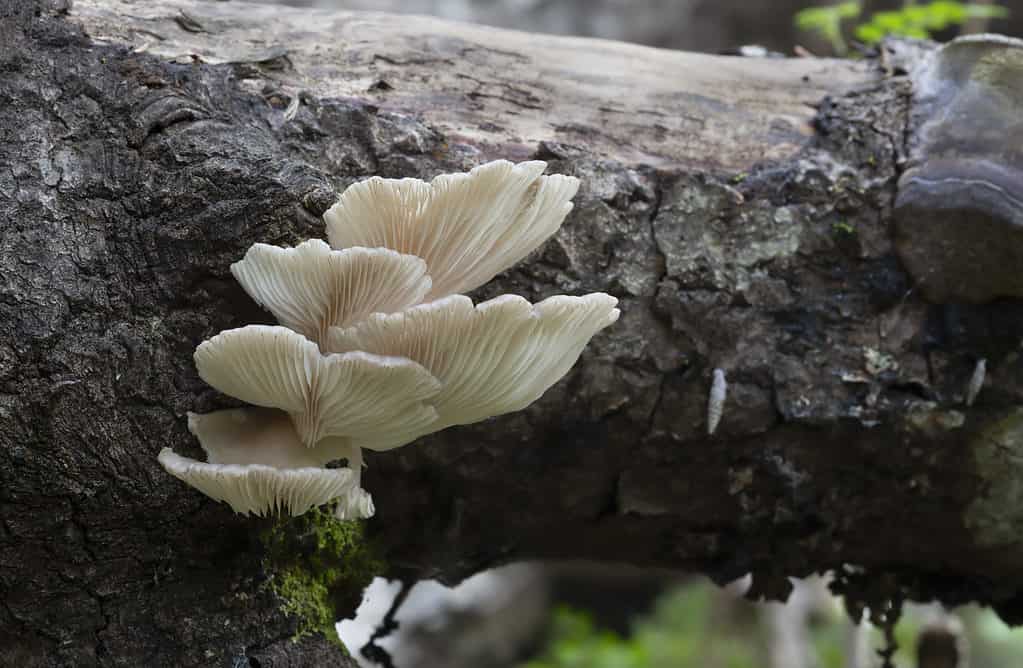
Oyster mushrooms like to grow on dead or decaying logs or stumps.
©iStock.com/Henrik_L
Reishi (Ganoderma sessile, Ganoderma lucidum)
These mushrooms aren’t super tasty, however, they’re highly prized for their medicinal benefits. Reishi mushrooms have been used in plant medicine practices for centuries and are still popular in the U.S. for their scientifically-backed benefits.
There are many species of reishi mushrooms all around the world and they’re all believed to have the same healing properties. These mushrooms supposedly improve liver functioning and support the immune system.
Ganoderma sessile and Ganoderma lucidum are the species you’re most likely to find around Missouri. Ischnoderma resinosum is considered a lookalike of reishi but it’s also edible, and apparently better for eating!
Reishi mushrooms grow horizontally out of wood, creating semicircular, shelf-like caps. Their caps are dark red where they connect to the wood, then fade to orange and have white tips. Older mushrooms will have a beige or gray underside, but you want the younger ones that have a white underside.
There are no toxic lookalikes for reishi mushrooms so they’re considered great for beginners!
They grow from May to November, decomposing pieces of dead wood. In particular, they like to grow on old or dead hardwoods like oak, elm, beech, and maple trees. Reishi produces mushrooms annually, which means that it will continue to fruit on the same piece of wood until it has decomposed all of it!
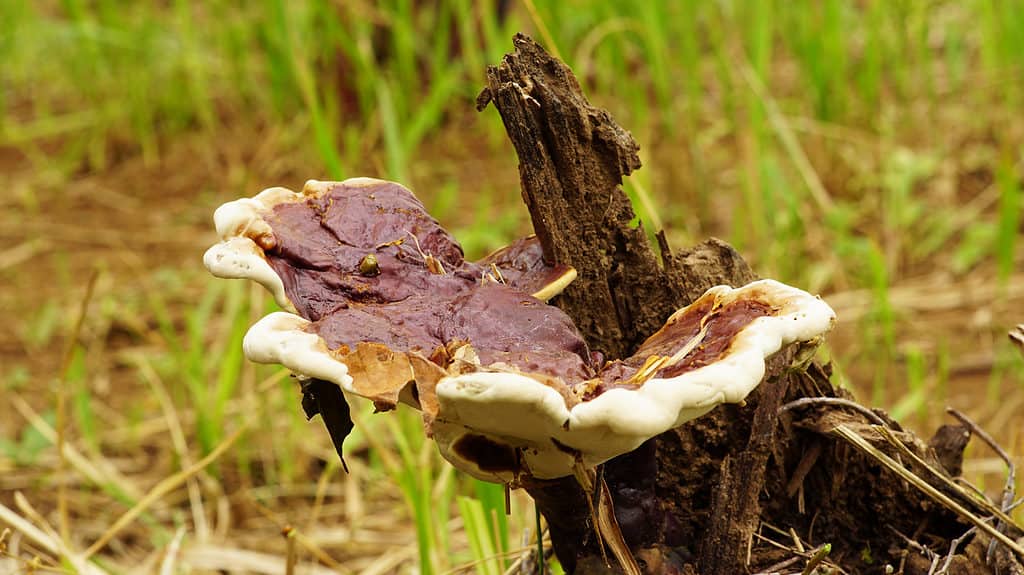
Reishi mushrooms grow horizontally out of wood, creating semicircular, shelf-like caps.
©iStock.com/wahid hasyim asyari
Common Toxic Mushrooms
Studying the toxic mushrooms also helps you gain confidence when identifying a wild mushroom. When you know what the highly toxic mushrooms look like you can be sure to steer clear of them.
Deadly Amanitas (Amanita phalloides, Amanita bisporigera)
There are a few mushrooms in the Amanita genus that are deadly if consumed, but there are two you should know well. These are the death cap (Amanita phalloides) and the destroying angel (Amanita bisporigera) – names you shouldn’t forget!
You might also hear Amanita bisporigera called the North American destroying angel because “destroying angel” is also used in Europe for Amanita verna. Don’t get too confused with names – all of these mushrooms are deadly to eat!
Both mushrooms are tall with large caps that are convex, although they flatten out over time. However, when these mushrooms are young, they go through an “egg phase” where they’re barely above ground and look like puffball mushrooms.
Both mushrooms are completely white, both their stipe and cap. The death cap can be slightly pale green or yellow and the destroying angel might have a light pink tint. In general, they’re conspicuous bright white mushrooms and their color should signal you to stay away!

Death cap mushrooms can be slightly pale green or yellow and are highly toxic.
©el_cigarrito/Shutterstock.com
False Morel (Gyromitra esculenta, Gyromitra montana)
When learning to hunt morels, it’s obviously helpful to learn to identify false morels. There are a few tell-tale signs so you can easily learn to tell them apart.
The easiest way to find out is to cut them in half. “True” morels have a completely hollow stipe while false morels will be solid. They’re also known as beefsteak or brain mushrooms because of their caps. Like morels, they have funky caps with ridges, but these have a wavy texture and look more like a brain!
You can also tell by their shape and size. Morel mushrooms grow upright, with a vertical shape, and have a conical cap. False morels are flatter and wider, closer to the ground.
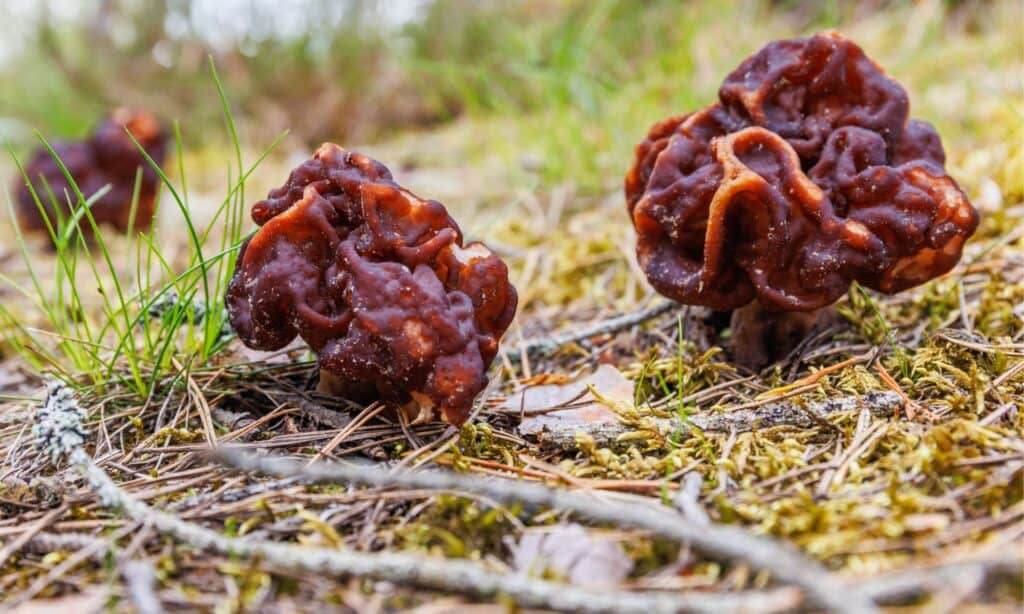
False morels have caps with ridges and a wavy texture that looks more like a brain than the honey comb ridges of true morels.
©iStock.com/TT
Deadly Galerina (Galerina spp.)
Deadly galerinas are also sometimes referred to the LBMs (little brown mushrooms) because most of the species reassemble each other and are hard to identify. This is tricky because some are toxic and others not – but it’s extremely difficult to know which is which.
However, none of the mushrooms in the Galerina genus are edibles, so you don’t need to bother trying to tell them apart, just avoid them altogether! Unless, of course, you’re identifying them to study – not to eat!
Galerina mushrooms can grow in clusters or grow individually. They’re very small mushrooms that are only a few inches high with a small cap that kind of resembles a tiny umbrella.
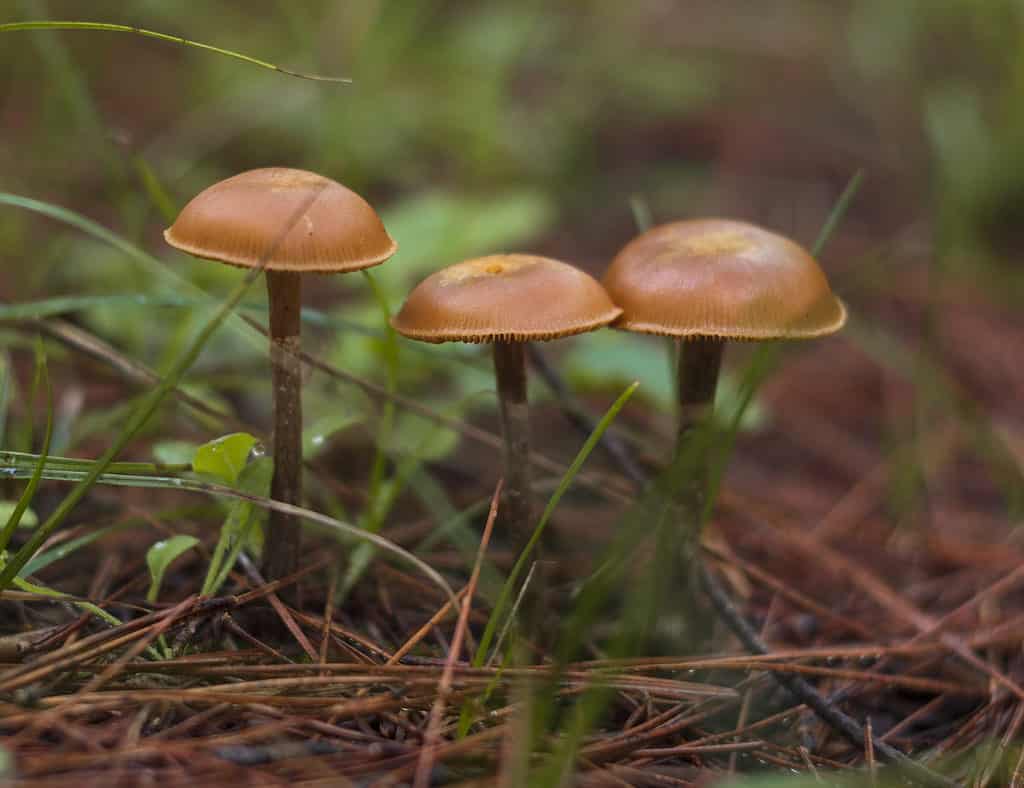
Deadly galerinas are non-edible little brown mushrooms that resemble tiny umbrellas.
©iStock.com/Alika Obrazovskaya
Where to Hunt for Mushrooms in Missouri
Of course, you need to start by hunting for mushrooms in places where it’s legal, as I explained in the earlier section. But, once you get there you might not know where to start looking.
Most mushrooms are fairly small and might be hiding under layers of fallen leaves, so they won’t be immediately visible. If you don’t already have an idea of where to look, you could wander around for hours and find nothing.
Many species of mushrooms grow on the forest floor, under the “forest fluff.” This is the layer of debris composed of fallen leaves, branches, small ferns, and bushes that provide lots of nutrients to mushrooms’ underground mycelial network.
Be aware that raking away and digging up leaves to search for mushrooms is a destructive practice that should not be used when mushroom hunting. In some places, you can get fined for this.
Also, keep in mind that every mushroom species has its habitat where it’s likely found. Your best strategy is to go hunting for one, maybe two specific mushrooms and learn what kind of environment they grow in.
The areas on and around the Ozark plateau are known to be abundant with mushrooms. It’s hard to learn about mushroom hot spots through the internet because most experienced hunters are hesitant to share their spots. You only find exact spots through experience!
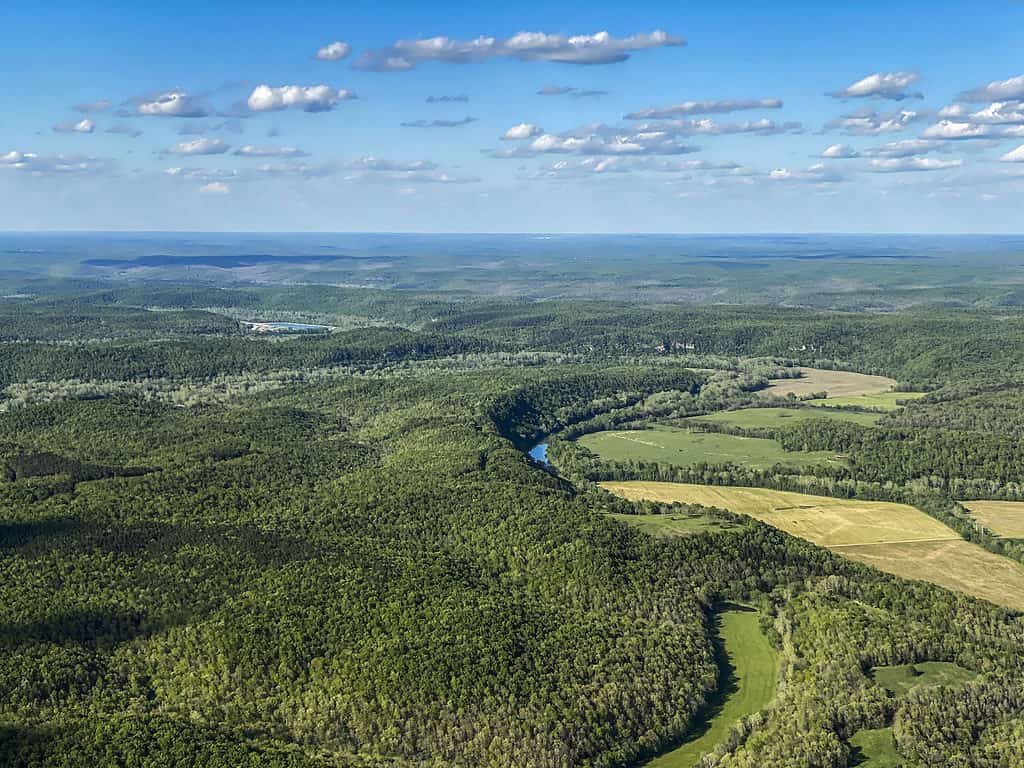
The areas on and around the
Ozark Plateau in Missouri are known to be great for mushroom hunting.
© – License
When to Go Mushroom Hunting in Missouri
There isn’t an overall “mushroom season” because mushroom fruiting times vary so much by species. Although, I can say that in general spring and fall tend to be prime times for mushroom hunting.
This is because most mushrooms grow best in temperate conditions with lots of moisture. So, the mild temperatures and consistent rainfall during spring and fall support lots of mushroom growth. This means that it’s possible to find mushrooms in the summer or winter, as long as it’s not too hot or cold and not too dry.
As with where to hunt, the question of when to hunt is highly dependent on species. Each species has its own season, so to ensure that you’re not going at the completely wrong time of year, research the species you want to find.
There are many factors that determine mushroom growth so even for exact species the season can vary. For example, if the spring is too dry, the morel season might be just one week. You can’t know for sure, but going based by species ensures that you’re not going 7 months early!

Spring and fall tend to be prime times for mushroom hunting because most mushrooms grow best in temperate conditions with lots of moisture.
©iStock.com/morgan23
Off to the Forest!
Mushroom hunting is a great hobby that you can continue to do and learn about all your life. It may seem like a lot of information at first, but don’t be intimidated. You have to start somewhere!
It’s crucial that you do lots of research before eating anything you find, but that doesn’t mean you have to be an expert. The best way to build up your knowledge is by going outside and just starting to take notice of the mushrooms around you!
Mushroom hunting is a great reason to go out into a local park or forest. If you go on walks or bike rides often, look closer at the mushrooms you’re passing.
You shouldn’t expect to come home with loads of fresh, edible mushrooms your first time out! It takes time to get good at identifying mushrooms and it’s important to build up experience.
Over time, you learn so much. You’ll be able to identify mushrooms and even tree species, you’ll find new hiking areas, and you’ll meet awesome “mushroomers.” Happy hunting!
Up Next
- 15+ Different Types Of Mushrooms, From The Edible To the Deadly
- Discover 10+ Different Types of Wild, Edible Mushrooms
- 8 Different Types of Poisonous Mushrooms You Should Avoid
The photo featured at the top of this post is © encierro/Shutterstock.com
The information presented on or through the Website is made available solely for general informational purposes. We do not warrant the accuracy, completeness, or usefulness of this information. Any reliance you place on such information is strictly at your own risk. We disclaim all liability and responsibility arising from any reliance placed on such materials by you or any other visitor to the Website, or by anyone who may be informed of any of its contents. None of the statements or claims on the Website should be taken as medical advice, health advice, or as confirmation that a plant, fungus, or other item is safe for consumption or will provide any health benefits. Anyone considering the health benefits of particular plant, fungus, or other item should first consult with a doctor or other medical professional. The statements made within this Website have not been evaluated by the Food and Drug Administration. These statements are not intended to diagnose, treat, cure or prevent any disease.
Thank you for reading! Have some feedback for us? Contact the AZ Animals editorial team.






